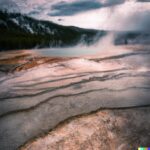Geothermal energy production is a fascinating topic that delves into the utilization of Earth’s natural heat for various purposes. From generating electricity to heating buildings, the uses of geothermal energy are vast.
This energy production also comes with environmental impacts, especially in delicate ecosystems like Yellowstone. Changes in geothermal features, disruption of wildlife habitats, and potential contamination are just some of the concerns.
Regulations and mitigation measures play a crucial role in managing these impacts, but exploring alternative energy sources is also essential. Join us as we dive into the world of geothermal energy production and its effects on Yellowstone’s ecosystem.
What is Geothermal Energy Production?
Geothermal energy production involves harnessing heat from within the Earth to generate power, making it a vital source of renewable energy globally.
- This process primarily entails extracting heat from geothermal reservoirs deep within the Earth’s crust.
- Geothermal plants utilize advanced technology to tap into these reservoirs, where hot water or steam is brought to the surface to drive turbines connected to generators, producing electricity.
- The key equipment used in geothermal power generation includes geothermal wells, heat exchangers, and power plants.
Geothermal energy is significant as it provides a continuous, reliable source of renewable power, contributing to reducing greenhouse gas emissions and promoting a sustainable energy future.
How Does Geothermal Energy Production Work?
Geothermal energy production works by tapping into the natural heat stored within the Earth’s crust through geothermal reservoirs and utilizing advanced technology for power generation.
- This process involves drilling wells into the ground to access the hot water and steam trapped in underground reservoirs.
- The high-pressure steam is then directed towards turbines, which drives generators to produce electricity.
Geothermal technology plays a crucial role in harnessing this renewable energy source and converting it into clean electricity.
- Geothermal heat pumps are used for heating and cooling applications by transferring heat between the ground and buildings, providing energy-efficient solutions for maintaining indoor comfort levels.
What Are the Uses of Geothermal Energy?
Geothermal energy finds diverse applications, including electricity generation, heating and cooling buildings through geothermal heat pumps, and supporting agriculture and aquaculture sectors.
This renewable energy source plays a crucial role in power generation by harnessing heat from beneath the Earth’s surface. Geothermal power plants utilize steam or hot water from geothermal reservoirs to produce electricity, providing a sustainable and reliable energy source.
In addition to powering homes and businesses, geothermal energy is also utilized in agriculture for greenhouse heating, soil sterilization, and crop drying processes. Aquaculture operations benefit from geothermal heat for maintaining optimal water temperatures for fish farming, contributing to efficient and environmentally-friendly practices.
What Are the Environmental Impacts of Geothermal Energy Production?
Geothermal energy production can have environmental impacts, including greenhouse gas emissions, ecosystem disruption, and sustainability challenges that need to be carefully managed.
- In terms of greenhouse gas emissions, geothermal energy is considered a cleaner alternative to fossil fuels, but there are still trace amounts of carbon dioxide and hydrogen sulfide released during the production process.
- Ecosystem disruption can occur when geothermal power plants alter the natural landscapes and habitats. To address these potential negative effects, sustainable practices such as proper site selection, water management, and monitoring of seismic activities are crucial in minimizing environmental impacts and ensuring the long-term viability of geothermal energy production.
Air Pollution
Air pollution is a concern associated with geothermal energy production, primarily due to the release of greenhouse gases during power generation processes.
- Geothermal power plants emit gases like carbon dioxide, hydrogen sulfide, and ammonia, contributing to air pollution. Compared to traditional fossil fuel power plants, geothermal facilities produce significantly lower levels of greenhouse gases.
- To further mitigate these emissions and reduce their impact on air quality, various strategies can be employed. These include the implementation of advanced emission control technologies, improved drilling and reservoir management techniques, and the adoption of closed-loop systems to minimize fluid and gas discharge into the atmosphere.
- By continuously enhancing these mitigation measures, the environmental footprint of geothermal energy can be further minimized.
Water Pollution
Geothermal energy production can lead to water pollution as thermal water from hydrothermal systems may carry harmful substances that impact water quality.
-
When geothermal power plants extract the heat from the underground reservoirs to generate electricity, they often release thermal water that contains various contaminants such as heavy metals, salts, and gases.
-
These contaminants have the potential to seep into surface water bodies, affecting aquatic ecosystems and posing risks to human health.
To address this issue, strict monitoring and treatment of thermal water discharge are essential to prevent or minimize water pollution impacts.
Technologies like sedimentation tanks, filtration systems, and chemical treatments are utilized to remove pollutants before releasing the water back into the environment.
Land Use and Habitat Destruction
Geothermal energy production can result in land use changes and habitat destruction, affecting ecosystem health and biodiversity in the surrounding areas.
The construction of geothermal energy plants often requires clearing large tracts of land, displacing native vegetation and wildlife populations. This disruption can fragment habitats, making it challenging for species to find suitable breeding grounds or food sources.
Drilling deep into the earth’s crust for geothermal exploration can disturb underground ecosystems. To combat these issues, conservation efforts and sustainable practices such as reforestation, habitat restoration, and implementing wildlife corridors are crucial in mitigating the negative impacts of geothermal energy production on land usage and ecosystem health.
How Does Geothermal Energy Production Affect Yellowstone’s Ecosystem?
The geothermal energy production in Yellowstone can significantly impact the ecosystem, altering geysers, wildlife habitats, and raising concerns about the environmental effects of geothermal exploration.
Since Yellowstone National Park sits atop a vast geothermal hotspot, the extraction of geothermal energy can result in changes to the thermal features that make the park renowned. These alterations can affect the delicate balance of the ecosystem, potentially disturbing the behaviors and habitats of the diverse wildlife that call the park home. The process of geothermal exploration within the park poses challenges related to managing the impact of drilling activities on the surrounding environment, which requires careful consideration and monitoring to mitigate any negative repercussions on the park’s natural beauty and biodiversity.
Changes in Geothermal Features
Geothermal energy production can lead to changes in Yellowstone’s geothermal features, affecting the park’s unique geologic landscape and ongoing geothermal projects.
These alterations are often evident in shifts in water chemistry, altered flow patterns, and changes in the temperature of geothermal pools and springs. The extraction of geothermal energy can disturb the natural balance of underground reservoirs, potentially leading to depletion or reduced productivity of hot springs and geysers. Such modifications pose challenges for preserving the delicate equilibrium of Yellowstone’s geothermal systems and raise concerns about the sustainability of ongoing geothermal projects in the area.
Disruption of Wildlife Habitat
The disruption of wildlife habitat in Yellowstone due to geothermal energy production raises concerns about ecosystem management and the preservation of critical habitats for diverse species.
Given that Yellowstone is a hotspot for biodiversity, it is crucial to carefully monitor the impact of geothermal energy activities on the various species that call the park home. Efforts to safeguard these habitats play a vital role in maintaining the delicate balance of the ecosystem within the park. Preservation initiatives must consider the interconnectivity of different species and how alterations to their habitats could have far-reaching consequences. By prioritizing habitat preservation, we can help ensure the long-term sustainability of wildlife populations in Yellowstone and protect the unique natural heritage of the park.
Potential for Contamination of Hot Springs and Rivers
Geothermal energy production poses a risk of contamination to hot springs and rivers in Yellowstone, underscoring the need for ecosystem balance and responsible geothermal infrastructure development.
The delicate ecosystem of Yellowstone National Park is at risk as geothermal activities can introduce harmful substances such as heavy metals and sulfides into the pristine waters. These contaminants can disrupt the natural balance of the aquatic environment, affecting the diverse species of plants and animals that depend on these waters for survival.
Therefore, it is crucial to implement sustainable infrastructure solutions that minimize the impact of geothermal operations on the surrounding ecosystem, ensuring the long-term health and sustainability of this unique natural habitat.
Noise and Visual Pollution
The presence of noise and visual pollution from geothermal energy activities in Yellowstone can impact visitors’ experiences and contribute to environmental effects within the park.
The constant hum of machinery and steam release can disrupt the tranquility of the natural surroundings, detracting from the overall ambiance that draws visitors to Yellowstone.
The visual intrusion of industrial infrastructure such as pipes and buildings can mar the scenic beauty that visitors come to admire, diminishing the aesthetic appeal of the landscape.
These disturbances not only affect visitor perceptions but also pose a threat to local wildlife by altering their natural habitats and behaviors.
What Are the Regulations and Mitigation Measures in Place for Geothermal Energy Production in Yellowstone?
Regulations and mitigation measures are essential for managing geothermal energy production in Yellowstone, focusing on conservation, biodiversity protection, and sustainable utilization of geothermal resources.
These regulatory frameworks play a crucial role in ensuring the balance between energy extraction and environmental preservation within the delicate ecosystem of Yellowstone. By implementing stringent guidelines, researchers and stakeholders strive to safeguard the unique flora and fauna that call this national park home.
Ongoing research efforts are dedicated to understanding the impacts of geothermal activities on the surrounding biodiversity and ecosystems, paving the way for sustainable resource management practices. Conservation measures are key in maintaining the natural beauty and ecological integrity of Yellowstone, while still harnessing the potential of its geothermal resources for energy production.
What Are the Alternatives to Geothermal Energy Production in Yellowstone?
Exploring alternatives to geothermal energy production in Yellowstone involves considerations of sustainability, diversified energy uses, and innovative applications that minimize environmental impacts.
- One potential alternative to traditional geothermal energy production methods in Yellowstone is the implementation of closed-loop geothermal systems, which can reduce water usage and minimize the risk of groundwater contamination.
- Exploring the feasibility of combining geothermal energy production with technologies such as solar panels and wind turbines can create a hybrid renewable energy system that maximizes efficiency and sustainability.
- Another innovative approach includes utilizing geothermal energy for district heating and greenhouse operations, promoting energy efficiency and reducing carbon emissions in the region.
These novel methods offer promising solutions to reduce the ecological footprint of energy projects in Yellowstone while meeting the growing demand for sustainable energy sources.
What Are the Economic Benefits of Geothermal Energy?
Geothermal energy offers significant economic benefits through job creation, energy independence, and a reliable source of renewable power.
The job creation potential of geothermal energy extends to various industries, from drilling and construction to maintenance and research, fostering a diverse workforce. By harnessing the Earth’s heat to generate electricity, nations can reduce their reliance on imported fuels, enhancing energy security and paving the way for a more self-sufficient energy landscape. The sustainable nature of geothermal power ensures a continuous and reliable source of energy, contributing to long-term environmental and economic stability.
What Are the Challenges in Geothermal Energy Development?
Geothermal energy development faces challenges related to technological complexity, financial investment requirements, and exploration risks that need to be addressed for sustainable growth.
- The technological barriers in geothermal energy development often involve designing reliable systems that can withstand high temperatures and corrosive elements present underground.
- The financial considerations pose a significant challenge as initial setup costs for geothermal power plants can be high.
- Exploration challenges arise due to the uncertainty of resource availability and the need for accurate site selection.
To overcome these obstacles, innovative approaches such as using advanced materials for infrastructure, leveraging financial incentives and partnerships, and improving exploration techniques through advanced imaging technologies can play a crucial role in driving the progress of geothermal energy development.
Last Updated on February 7, 2024 by Jon Waraas – Originally Posted: February 7, 2024

I’m Jon Waraas, and I’ve been navigating the online world since 2006. By day, I’m the proud owner of some eCommerce gems, and by night, I’m the voice behind the adventures on Waraas.Com.
My heart, however, belongs to the wild beauty of Yellowstone National Park. I’ve got a collection of websites dedicated to sharing the wonders of this natural masterpiece. Oh, and did I mention? I’m currently building my own cabin inside the ghost town of Gilmore, Idaho – a cabin with tales to tell!
When I’m not immersed in the digital realm, you’ll find me lacing up my boots for a good hike or setting up camp under the star-studded sky.




